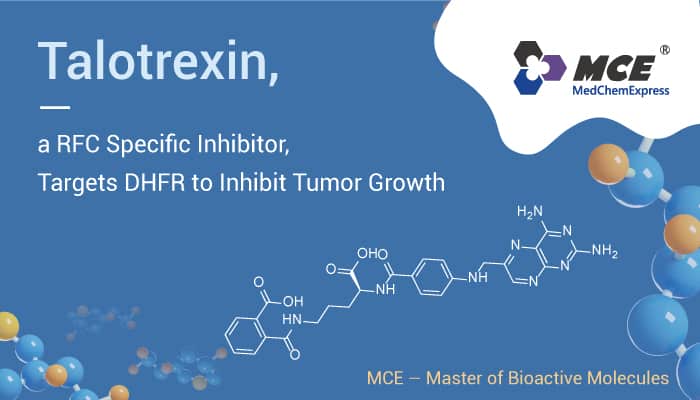In this article, we will introduce a potent RFC (reduced folate carrier) specific inhibitor Talotrexin (PT523). Talotrexin, an analog of Aminopterin, is a nonpolyglutamatable classic antifolate. Additionally, it selectively inhibits RFC transport.
Mammals cannot synthesize folates de novo, their cellular uptake from the extracellular milieu is essential. Besides, The uptake of folates into mammalian cells is mediated by facilitative transporters, including the reduced folate carrier (RFC), et al.
These uptake systems are genetically distinct and functionally diverse, and each plays a unique role in mediating folate uptake across epithelia and into systemic tissues. RFC is ubiquitously expressed and is the primary tissue folate transporter. Classic antifolates (e.g., MTX, PMX) are substrates for RFC, with varying transport via PCFT and FRs.
It is essential to ensure sufficient intracellular drugs to inhibit enzyme targets via facilitated uptake.

However, as RFC substrates, Classic antifolates show limited selectivity toward tumors over proliferative tissues (e.g., bone marrow).
As a potent RFC inhibitor, Talotrexin (1-1000 nM) inhibits the proliferation of R1-11/Tet-on-RFC HeLa cells. What’s more, Talotrexin shows no significant PCFT or FRα inhibitory activity.
In NSCLC xenografts in athymic female nude mice (6-8 weeks), Talotrexin alone inhibited the growth of A549 human NSCLC carcinoma. Additionally, Talotrexin shows antitumor activity by targeting DHFR to inhibit tumor growth. Talotrexin (0-35 mg/kg, IV injections, once weekly for 4 weeks) alone or combined with Paclitaxel (, 7.5 mg/kg) inhibits A549 tumor growth in mice.
At the same time, it demonstrated statistically significant inhibition when combined with paclitaxel. Talotrexin inhibits A549 tumor growth. At Day 30, Talotrexin at 25 and 35 mg/kg led to changes in tumor volumes. ). Furthermore, Talotrexin at 15, 25, and 35 mg/kg in combination with Paclitaxel at 7.5 mg/kg significantly inhibited tumor growth. Percent change in tumor volume was 379.5, 214.7 (p < 0.01), and 409.2 (p < 0.05), respectively in combination with Talotrexin at 15, 25, and 35 mg/kg. Notably, there are no obvious toxic effects in this study.
In conclusion, Talotrexin is a potent RFC inhibitor for tumor research.
[1]. O’Connor C, et al. Sci Rep. 2021 Mar 18;11(1):6389.
[2]. Choy G S, et al. Cancer Research, 2007, 67(1_Annual_Meeting).